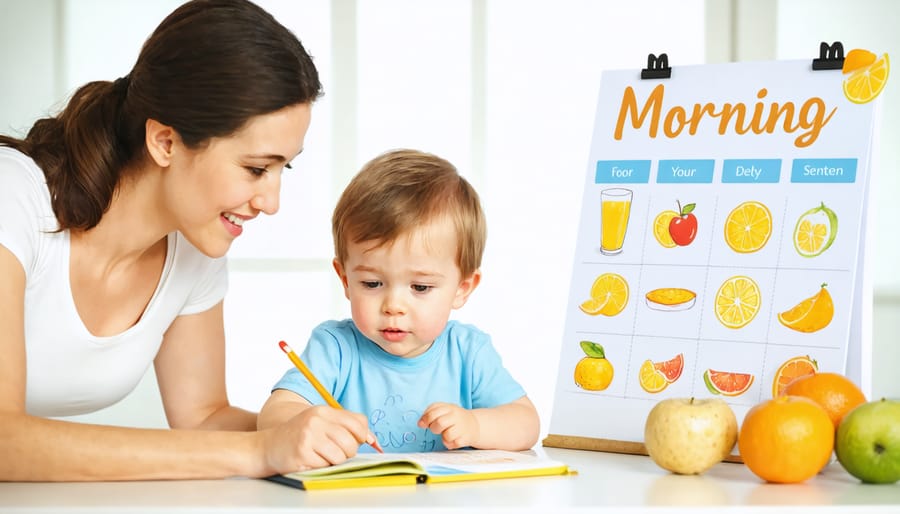
Transform your parenting journey with a proven system that helps you navigate parenting challenges while building lasting connections with your children. As a mother of three and family therapist for over 15 years, I’ve distilled the essentials of effective parenting into seven practical steps that work for families of all shapes and sizes.
Picture this: Your morning routine flows smoothly, bedtime battles become a thing of the past, and you finally feel confident in your parenting decisions. This isn’t just a dream – it’s exactly what thousands of parents have achieved using this structured approach to family management.
The beauty of this seven-step system lies in its flexibility and real-world applicability. Whether you’re dealing with toddler tantrums or teen attitude, these strategies adapt to your unique family dynamics while maintaining consistency and emotional connection. You’ll learn to set boundaries without guilt, communicate effectively across age groups, and create a harmonious household that thrives on mutual respect and understanding.
Let’s face it: parenting doesn’t come with a manual, but this system provides the next best thing – a clear roadmap to success that eliminates guesswork and builds confidence. Ready to transform chaos into calm and confusion into clarity? Let’s dive into the seven steps that will revolutionize your approach to parenting.
Building Strong Foundations: Step 1 – Creating Your Family Vision
Why Your Family Needs a Vision Statement
Just as successful businesses operate with a clear vision, your family can benefit immensely from having its own vision statement. Think of it as your family’s North Star – a guiding light that helps everyone stay focused on what truly matters.
I remember when my own family created our vision statement during a Sunday afternoon pizza-making session. We all contributed ideas about what we wanted our family to represent, and it became a powerful moment of connection and clarity.
A family vision statement helps you make decisions that align with your values, whether it’s choosing activities, setting boundaries, or navigating challenges. It’s like having a filter that helps you say “yes” to what matters and “no” to what doesn’t.
Your vision statement might include elements like “We support each other’s dreams,” “We prioritize quality time together,” or “We practice kindness and respect.” The key is making it authentic to your family’s values and aspirations.
When everyone understands and embraces this shared vision, daily parenting decisions become clearer, and your family moves forward with purpose and unity.
Creating Your Family Values Together
Creating family values isn’t just about parents dictating rules – it’s a collaborative journey that strengthens your family bond. Start by gathering everyone for a fun “Family Values Adventure” session. Grab some colorful sticky notes and markers, and ask each family member to write down what matters most to them. Even little ones can participate by drawing pictures!
Turn it into a game by having everyone share their ideas and group similar values together. You might be surprised to hear your eight-year-old talk about the importance of being kind to others, or your teenager emphasizing honesty. Create a family values poster together, using images and words that represent your shared principles.
Make it practical by brainstorming ways to live these values daily. If “respect” is important, discuss specific actions like listening without interrupting or knocking before entering rooms. Schedule monthly check-ins to celebrate moments when family members demonstrated these values and adjust them as your family grows.
Remember, the key is making this process inclusive and enjoyable. When children help create family values, they’re more likely to embrace and practice them naturally.

Step 2 – Establishing Consistent Routines
Morning and Evening Ritual Ideas
Establishing consistent morning and evening rituals can transform chaotic households into harmonious homes. For toddlers (ages 2-4), keep mornings simple with a picture chart showing basic tasks like making the bed, getting dressed, and brushing teeth. Make it fun by turning it into a “ready for adventure” game.
School-age children (5-12) thrive with more structured routines. Create a morning checklist that includes homework check, backpack prep, and a quick family breakfast. In the evening, implement the “15-minute tidy” where everyone pitches in to clean up before dinner.
For teenagers, respect their changing sleep patterns while maintaining boundaries. Encourage them to prep school materials and clothes the night before. A evening wind-down ritual might include 30 minutes of phone-free time and a brief family check-in.
Pro tip: Whatever the age group, consistency is key. Start small with just two or three ritual elements and gradually build up. Remember to adjust routines during weekends and holidays while keeping core elements intact to maintain stability.

Making Routines Fun and Engaging
Transform mundane daily routines into exciting adventures by adding a dash of creativity and playfulness. I remember when my daughter refused to brush her teeth until we turned it into a “cavity-fighting superhero mission” – complete with sound effects and special moves! Try setting timers for routine tasks and turning them into friendly competitions. Who can put away their toys the fastest while dancing to their favorite song?
Make morning routines more engaging with a colorful checklist where kids can place stickers or draw happy faces after completing each task. For younger children, create routine cards with pictures they can flip over as they progress through their day. This gives them a sense of control and accomplishment.
Consider introducing a points system where children earn “stars” for completing routines independently. These points can be exchanged for small rewards or special privileges. Remember to keep it light and fun – when children feel like they’re playing rather than being ordered around, they’re more likely to cooperate and develop positive habits that last.
Don’t forget to celebrate their successes, no matter how small. A simple high-five or silly victory dance can make routine tasks something to look forward to rather than dread.
Step 3 – Effective Communication Strategies

Active Listening Techniques
Active listening is more than just hearing words – it’s about creating a safe space where your child feels truly understood. I remember when my daughter was struggling with playground drama, and simply sitting with her, maintaining eye contact, and reflecting her feelings back made all the difference. This mindful parenting approach helps build trust and emotional connection.
Start by getting down to your child’s physical level when they’re speaking. Remove distractions like your phone, and use encouraging phrases like “I see,” or “Tell me more about that.” When they express emotions, validate their feelings before jumping to solutions: “That must have felt really frustrating” or “I understand why you’d feel sad about that.”
Pay attention to their non-verbal cues – body language often tells more than words. Practice reflecting their emotions: “It sounds like you’re feeling disappointed because…” This technique shows you’re truly engaged and helps them develop emotional vocabulary.
Remember, the goal isn’t to fix everything but to make your child feel heard and supported. Sometimes, a simple “I’m here for you” is more powerful than any advice.
Age-Appropriate Conversations
Just like we adjust our wardrobe as our children grow, we need to tailor our communication style to match their developmental stages. I learned this lesson firsthand when my preschooler’s endless “why” questions transformed into deeper conversations about emotions and friendships as she entered elementary school.
Start by meeting your child where they are. For toddlers, keep conversations simple and concrete, using basic words and lots of facial expressions. Preschoolers thrive on storytelling and imaginative dialogue, so weave life lessons into bedtime stories or pretend play scenarios.
School-age children are ready for more complex discussions about feelings, relationships, and consequences. Create safe spaces for them to express their thoughts without judgment. With teenagers, respect their growing independence by listening more than lecturing. Ask open-ended questions and acknowledge their perspectives, even when you disagree.
Remember, effective communication isn’t just about the words we use – it’s about creating age-appropriate opportunities for connection. When we adjust our approach to match our children’s developmental stage, we build stronger bonds and foster meaningful conversations that grow with them.
Step 4 – Positive Discipline Methods
Natural Consequences vs. Punishment
Understanding the difference between natural consequences and punishment can transform your parenting approach. While punishment focuses on making children feel bad about their choices, natural consequences teach valuable life lessons organically. As a mom who once struggled with this distinction, I’ve learned that letting natural consequences play out often creates more meaningful learning experiences.
For example, if your child refuses to wear a coat despite your suggestion, letting them feel cold (while keeping a coat handy) teaches them about weather-appropriate clothing more effectively than forcing them or punishing their choice. These experiences, combined with gentle discipline techniques, help children develop better decision-making skills.
However, natural consequences aren’t always appropriate, especially when safety is concerned. You wouldn’t let a toddler learn about hot stoves through experience! In these cases, loving guidance and clear boundaries are essential. The key is to remain consistent and calm, focusing on teaching rather than punishing. Remember, our goal isn’t to make children suffer for their mistakes but to help them learn from them.
Setting Healthy Boundaries
Setting healthy boundaries isn’t just about saying “no” – it’s about creating a framework where both parents and children can thrive. I remember when my daughter started testing limits at age three, and establishing clear boundaries transformed our daily routine from chaos to harmony.
Start by identifying your non-negotiables – those essential rules that protect your children’s safety and well-being. Whether it’s screen time limits, bedtime routines, or respectful communication, make these boundaries crystal clear and consistently enforce them. The key is to communicate these limits with confidence and compassion.
Remember to adjust boundaries as your children grow. What works for a toddler might not suit a teenager. When explaining boundaries, use age-appropriate language and always provide the reasoning behind them. This helps children understand that boundaries aren’t arbitrary restrictions but loving guidelines for their benefit.
Stay firm yet flexible. While core safety rules are non-negotiable, consider allowing some wiggle room in less critical areas. This teaches children about compromise while maintaining structure. Most importantly, model the boundaries you set – children learn more from what we do than what we say.
Step 5 – Quality Time Implementation
Creating Special Moments
In our fast-paced world, creating meaningful connections with our children sometimes feels like an uphill battle. But here’s the thing – it’s not about grand gestures or elaborate plans; it’s about those small, intentional moments that build lasting bonds.
Start by scheduling regular one-on-one time with each child. This could be as simple as a 15-minute bedtime chat or a weekend breakfast date. My daughter and I have our special “pancake Saturdays,” where we experiment with fun toppings while sharing stories about our week. These moments become treasured rituals that children look forward to.
For family activities, think beyond the obvious. Sure, movie nights are great, but consider starting a family book club, having dance parties in the living room, or creating a family garden. The key is engaging in activities that encourage conversation and collaboration. One of my favorite approaches is the “kid’s choice day” – where each child takes turns planning a family activity within set parameters.
Make everyday moments special by adding unexpected elements. Turn mundane car rides into storytelling sessions, transform cleanup time into a race against the clock, or create silly nicknames for regular household tasks. These small touches add magic to ordinary moments.
Remember to put away your phone during these special times. Being fully present sends a powerful message that your children are your priority. Document these moments if you wish, but do it after the experience, not during.
The beauty of creating special moments lies in their simplicity and consistency. They don’t need to be perfect or Instagram-worthy; they just need to be genuine and meaningful for your family.
Step 6 – Self-Care for Parents
Finding Balance in Parenting
Being a parent doesn’t mean you have to lose yourself in the process. Finding balance is like being on an airplane – you need to put your oxygen mask on first before helping others. As a mom of two, I’ve learned that implementing self-care practices for parents isn’t selfish; it’s essential for the whole family’s wellbeing.
Start by identifying your non-negotiables – those activities that keep you grounded and energized. Maybe it’s a 20-minute morning workout, a quiet cup of coffee, or a weekly catch-up with friends. Schedule these moments like you would any important appointment.
Create a support system that works for you. This might mean trading childcare hours with other parents, involving your partner more actively, or hiring help when possible. Remember, it takes a village, and there’s no shame in asking for support.
Set realistic expectations for yourself. You don’t need to be “on” 24/7. Establish boundaries around work, family time, and personal space. When my children were younger, I introduced “quiet time” each afternoon – they knew this was mommy’s recharge period, and it became a natural part of our routine.
Use time-blocking to your advantage. Dedicate specific times for focused parent-child activities, household tasks, and personal pursuits. This helps reduce the guilt of taking time for yourself because you know you’re also giving quality attention to your children during their designated times.
Remember that balance looks different for everyone, and it’s okay if your version doesn’t match someone else’s. The key is finding what works for your family while ensuring your own cup stays full enough to pour into others.
Step 7 – Regular Family Check-ins

Monthly Family Meetings
Monthly family meetings might sound formal, but trust me, they’re a game-changer in creating a harmonious household. I remember when my own family started this practice – it transformed our communication and brought us closer together. Think of it as your family’s regular check-in time, where everyone gets a voice and feels heard.
Start by scheduling a consistent time each month – perhaps Sunday afternoon after lunch when everyone’s relaxed. Create a cozy atmosphere by gathering in the living room with some snacks. The key to successful family meetings lies in following a simple structure while keeping things light and engaging.
Begin with appreciation rounds, where each family member shares something positive about another family member. This sets a constructive tone and is crucial for building family emotional resilience. Next, discuss any challenges or concerns that need addressing – from household chores to screen time limits.
Make it interactive by using a “talking stick” (any special object will do) to ensure everyone gets uninterrupted speaking time. Keep a family meeting journal to track decisions and progress. End each meeting by planning something fun together – maybe a weekend activity or a special family dinner.
Remember to adjust the format based on your children’s ages. For younger kids, keep meetings shorter and incorporate fun elements like drawing their ideas. With teens, focus more on collaborative problem-solving and giving them leadership roles in family decisions.
The magic happens when these meetings become a regular part of your family rhythm, creating a safe space for open dialogue and stronger connections.
Embarking on your journey with the 7-Step Parenting Success System can transform your family dynamics in ways you never imagined. As a mom who’s been exactly where you are now, I can tell you that implementing these steps has not only made parenting more manageable but also more joyful and rewarding.
By following this structured approach, you’ll discover newfound confidence in your parenting decisions, experience fewer power struggles, and create deeper connections with your children. The beauty of this system lies in its flexibility – you can adapt it to your family’s unique needs while maintaining its core principles.
Remember, positive change doesn’t happen overnight, and that’s perfectly okay. Start with one step at a time, celebrate small victories, and be patient with yourself as you grow into this new approach. The most important thing is to begin.
Your children deserve the best version of you, and you deserve the peace of mind that comes with having a reliable parenting framework. Take that first step today – your future self will thank you for it. Together, we’re building stronger, happier families, one step at a time.



